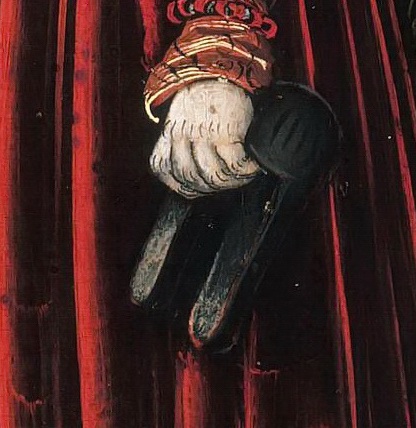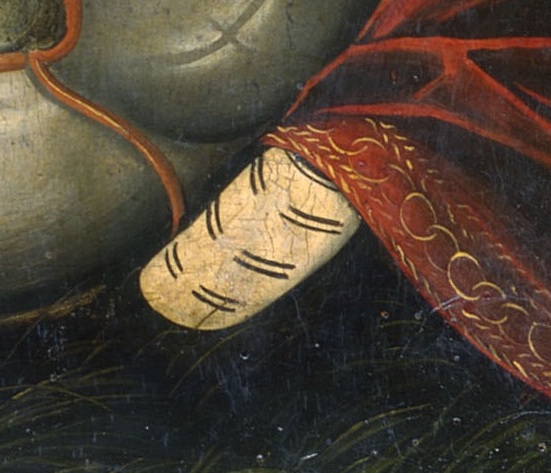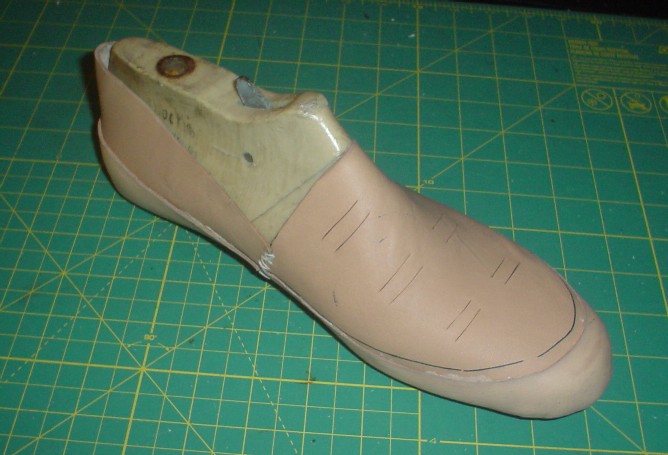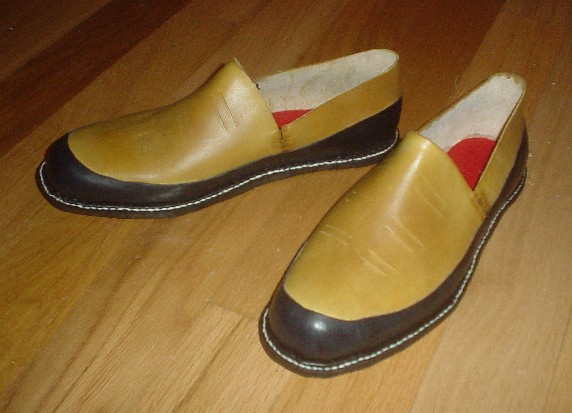A new project – these are rather unusual shoes, and are based on a couple of images from some German painters (Cranach, most notably). First, let me give you finished product (although the picture does not really do them justice) and then go into detail.
Updated: 9/7/20 – it has been 9 years since I made these shoes. I’ve found quite a few more examples, but those only serve to further complicate things. As it should be, a good mystery! But, the indications are that at least in one example, the “black lines” in some of these shoes almost appear to be laces of some kind rather than simple slashes. This makes some sense, as the lines in all of the images are actually quite dark compared to their white contrasting background. Moreover, if they were indeed laces, they could just as easily have been made with white material as with black, which might explain the red and white shoe with no apparent laces, but there does not seem to be any evidence of lacing on that pair.
Here are a few close-up images of these two-toned shoes, with the sources listed likewise. Note that I do not distinguish between the Elder and the Younger (bad Francis) – moreover, these pieces were widely copied, but I believe I have the originals.
 1526 Lucas Cranach, David and Bathsheba
1526 Lucas Cranach, David and Bathsheba
 1528 Cranach, Samson and Delilah
1528 Cranach, Samson and Delilah
 1534 Cranach, David und Bathseba
1534 Cranach, David und Bathseba
 1537 Cranach, Samson and Delilah
1537 Cranach, Samson and Delilah
 1534 Cranach, David und Bathseba
1534 Cranach, David und Bathseba
 1546 Cranach, The Fountain of Youth
1546 Cranach, The Fountain of Youth
Curious shoes, wouldn’t you say? We don’t have any extant shoes in the 16th century (at least none that I know of) which have any kind of applique or other banding (although chopines are a bit different). Likewise, there is no indication as to how this would have been done. It is certainly possible that they are constructed like the wedges in Lesson 9 only with a contrasting surround on the bottom, but the contrasting color seems to go up too far.
Update: The 1528 Cranach is likely the most illuminating. It shows bands of laces coming all the way across the top of the shoe, and disappearing before getting to the “black” banded area. Moreover, there even seems to be a “clip” of some kind that could arguably be a tensioner of some kind. I’ll have to check the next time I am visiting the Met in NYC, as it is housed there. However, I am far more comfortable now about the black laces (even if just for ornamentation) instead of slits. Additionally, there are other images which details the presence of shoes and pantofles (1537) and just pantofles (1526).

I first put together a test piece and lasted it. I skived the edges and pasted on the surround strip and then caught it in with the upper for the sides. Looking back, I probably should have made the place where the quarters meet the vamp a bit lower, but we know for next time. In general, the paste held on pretty well, so I decided to go with this construction. Thinking back, I probably should have stitched them right-sides-to-right-sides and then folded it down and beaten it flat. I may try that if I ever do a second pair.
A shot of the uppers with the strips pasted down. I also realized that I seldom show the shoes actually lasted, so I decided to take a photo this time.
In general, I’m reasonably happy with the attempt, although the more I look at my work, the more I realize that the lasts I am using are just not quite right. For the 16th C, the lasts should be curved inwards at the bottom so that the welt is more tucked underneath the upper, but because I am using modern lasts, the shoe basically drops straight down, pushing the welt out further. For the next pair I make, I am going to round the bottom of the last dramatically to see how it arrives at a more period look.




Very intereesting and new to me. Thanks for bringing this up! Very nice work indeed and a great site you are maintaining here!
I agree on the modern last problem, they tend to give shoes a look too reminiscent of more modern shoe forms. Looking forward to see you attempts at modifying the lasts!
Best,
Martin
Thanks for the kind words! We’ve got a team together to do some early Tudor cow mouth shoes, and we’re working some more period looking lasts for those. Should be lots of fun, and I’ll be sure to post some details once we get them rolling.